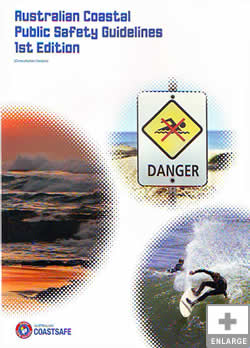Coastal Safety Guidelines
Surf Life Saving Australia developed the Australian Coastal Public Safety Guidelines following research in Australia and Internationally, and through extensive industry consultation.
The Guidelines were released in 2007 as a ‘consultative edition’ and offer valuable guidance for all coastal land owners and land managers as well as anyone conducting an activity or event.
The Guidelines will assist the careful evaluation of risks associated with specific uses of the coastal environment and Surf Life Saving Northern Territory stands ready to assist. For example, a community group is planning a day at the beach. They consult Guideline GO1320 and find advice on general safety, a Group Leader checklist, ratios for supervising children in the water and more.
NATIONAL AQUATIC AND RECREATIONAL SIGNAGE STYLE GUIDE
The National Aquatic and Recreation Signage Style Guide provides "best practice" design information to review and implement a signage system based on a standardised framework that will deliver important safety information in a consistent fashion. Surf Life Saving NT is able to provide advice and information relating to signage in a beach or coastal environment.
AUSTRALIAN BEACH SAFETY AND MANAGEMENT PROGRAM (ABSAMP)
The Australian Beach Safety & Management Program (ABSAMP) was established in 1990 as a joint program between SLSA and the Coastal Studies Unit, University of Sydney. ABSAMP is an ambitious project that aims to be the most comprehensive study ever undertaken on the beaches of any part of the world's coast. Detailed information on every beach in Australia has been amassed.
The main aims of the program are to:
- develop a comprehensive, standardised and scientific information base on all Australian beaches with regard to their location, physical characteristics, access, facilities, usage, rescues, physical and biological hazards, and level of public risk under various wave, tide and weather conditions
- expand and improve the management and safety services of all Australian beaches, and to assist other countries to develop similar programs
ABSAMP recognises 5029 km of Northern Territory coastline. 38% of this coastline is taken up by the territory’s 1,488 beaches. Each beach is given an ABSAMP number and is classified according to 12 beach types. There are over 200 ‘surf beaches’ in the Northern Territory - almost all are on the exposed east Arnhem Land coast. 14 of these beaches are classified as ‘Transverse bar and rip beaches’ and are potentially hazardous for swimmers and surfers.
COASTAL SAFETY RISK ASSESSMENT
Surf Life Saving NT provides a valuable coastal safety risk assessment and auditing service to land owners and land managers within all areas of the government and private sectors. At a specified location our Risk Assessors use resources such as ABSAMP research and best practice signage manuals to identify the hazards, the level of risk and the potential for injury. The outcome of a Coastal Risk Assessment is a comprehensive Risk Management Plan and a safer location for the community to enjoy.
As soon as you become aware of your involvement in a Special Event you should contact SLSNT to discuss the essential approval process that you or your club needs to complete. Applications to conduct a special event should be submitted one month prior to the event.
No commitment, without reservation, shall be given by SLSA members until final approval is given by the appropriate authority of SLSA.
|

Safety checks & equipment
Check your safety equipment and carry the required quantity. Ensure it is in good condition, of regulation standard and that it is stowed properly. Visit the NT Government’s Transport Group site for the latest Marine Safety Regulations. Go to www.nt.gov.au/transport
Know your navigation rules, especially the basic "Rules of the Road" at sea, channel and hazard markers, buoyage and lights.
Tell someone where you are going. Before departing, advise a relative or responsible friend of your proposed itinerary and expected time of return and also give them a description of your boat and tell them who is travelling with you.
Check the weather, if in doubt don't go out. For weather information phone the Bureau of Meteorology.
Check your fuel. Ensure you have enough for the trip with an adequate reserve for an emergency. Make sure your fuel lines and tanks are in good condition and that they don't leak. It is advisable to always use fresh fuel and keep it in an airtight container.
Carry a chart of the area. Study it and familiarise yourself with positions of the navigational aids and hazards you are likely to encounter.
Don't overload your boat. Distribute weight evenly and use the supplier's recommendations as to the maximum carrying capacity of your vessel.
Before departing check your boat and motor(s) and ensure they are in sound working order and drain plugs are tightly inserted.
Carry appropriate tools and spares in case or breakdown:
- spark plug and spark plug spanners
- spare propeller
- penetrating fluid
- shear pins and split pins
- spanners, screwdriver, pliers etc.
- Drain Plugs
Keep a good lookout at all times. Proceed with caution in unfamiliar waters.
Alcohol and boating don't mix! The person in charge of the vessel is responsible for the safety of the craft and the lives of the passengers. Alcohol is a significant factor in many boating accidents.
|